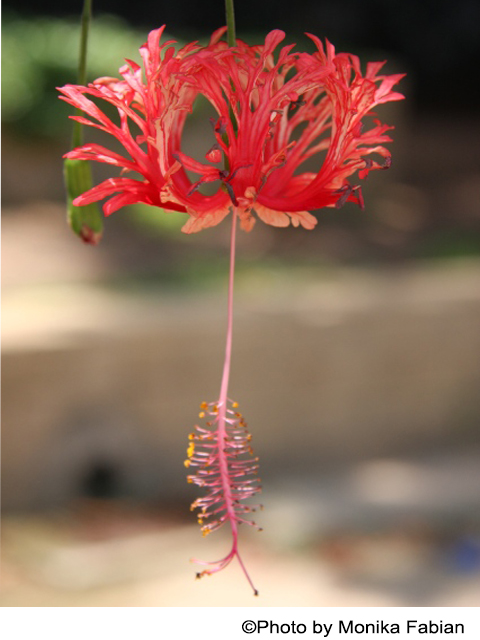Hibiscus schizopetalus (Japanese lantern)
Japanese lantern has glossy green leaves and produces very large, disc-shaped flowers. In the center of each bold bloom is a bottlebrush of yellow anthers and topped with five-parted, spider-like stigmas. The fruit is a brown capsule. Tropical hibiscus is heat tolerant and prefers full sun and mildly acid to neutral, well-drained soil. It blooms in new wood therefore early spring pruning could enhance blooming. The plant cannot take frost. In frost free zones it can be grown in mixed borders or along foundations. It has high water requirement therefore not recommended for dry zones.
- Landscape Information
- Botanical Description
- Horticulture Management
-
By Botanischer Garten TU Darmstadt [CC BY 2.0 (http://creativecommons.org/licenses/by/2.0)], via Wikimedia Commons
-
-
By Karelj (Own work) [CC-BY-SA-3.0 (http://creativecommons.org/licenses/by-sa/3.0) or GFDL (http://www.gnu.org/copyleft/fdl.html)], via Wikimedia Commons
-
Atamari [CC BY-SA 3.0 (http://creativecommons.org/licenses/by-sa/3.0)], via Wikimedia Commons
Search plant on Google
Download as PDF
-
French Name: Lanterne Japonaise ou Hibiscus corail
Arabic Name: Hibiscus yabani
Pronunciation: hi-BIS-kus skiz-oh-PET-al-us
-
Plant type: Shrub
-
Origin: Kenya, Tanzania, Mozambique
-
Heat Zones: 1 to 14
Hardiness Zones: 10 to 13
-
Uses: Screen, Hedge, Specimen, Wildlife
-
Size/Shape
Growth Rate: Moderate
Tree Shape: Round, oval
Canopy Symmetry: Symmetrical
Canopy Density: Medium
Canopy Texture: Fine
Height at Maturity: 1.5 to 3 m
Spread at Maturity: 1.5 to 3 meters
Time to Ultimate Height: 5 to 10 Years
-
By Botanischer Garten TU Darmstadt [CC BY 2.0 (http://creativecommons.org/licenses/by/2.0)], via Wikimedia Commons
-
-
By Karelj (Own work) [CC-BY-SA-3.0 (http://creativecommons.org/licenses/by-sa/3.0) or GFDL (http://www.gnu.org/copyleft/fdl.html)], via Wikimedia Commons
-
Atamari [CC BY-SA 3.0 (http://creativecommons.org/licenses/by-sa/3.0)], via Wikimedia Commons
Search plant on Google
Download as PDF
-
Foliage
Leaf Arrangement : Alternate
Leaf Venation: Pinnate
Leaf Persistance: Evergreen
Leaf Type: Simple
Leaf Blade: 5 - 10 cm
Leaf Shape: Obovate
Leaf Margins: Serrate
Leaf Texture: Smooth
Leaf Scent: No Fragance
Color(growing season): Green
Color(changing season): Green
-
Flower
Flower Size Range: 3 - 7
Flower Type: Solitary
Flower Sexuality: Monoecious (Bisexual)
Flower Scent: No Fragance
Flower Color: Red
Seasons: Year Round
-
Trunk
Trunk Susceptibility to Breakage: Generally resists breakage
Number of Trunks: Multi-Trunked
Trunk esthetic Values: Not Showy
-
Fruit
Fruit Size Range: 1.5 - 3
Fruit Color: Brown
Seasons: Year Round
-
By Botanischer Garten TU Darmstadt [CC BY 2.0 (http://creativecommons.org/licenses/by/2.0)], via Wikimedia Commons
-
-
By Karelj (Own work) [CC-BY-SA-3.0 (http://creativecommons.org/licenses/by-sa/3.0) or GFDL (http://www.gnu.org/copyleft/fdl.html)], via Wikimedia Commons
-
Atamari [CC BY-SA 3.0 (http://creativecommons.org/licenses/by-sa/3.0)], via Wikimedia Commons
Search plant on Google
Download as PDF
-
Tolerance
Heat Tolerance: Yes
Salt Tolerance: Poor
-
Requirements
Soil Requirements: Loam, Sand
Soil Ph Requirements: Acidic, Neutral
Water Requirements: Moderate
Light Requirements: Full, Part
-
Management
Susceptibility to Pests and Diseases: Yes
Pruning Requirements: Needed, to develop a strong structure
Fruit/ Leaves/ Flowers litter: No
Life Span: Less than 25
Diseases: Leaf Spots, Root rot
Edible Parts: None
Pests: Mites, Thrips, Caterpillars, Whitefly, Aphids, Mealy-Bug
Plant Propagation: Cutting

